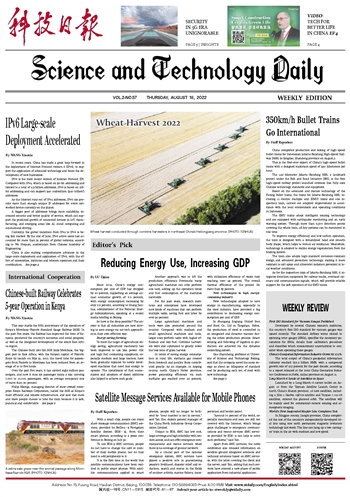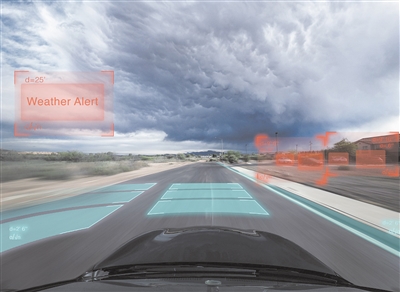
 Security in 5G Era Unignorable
Security in 5G Era Unignorable Tech For Better Life in China-EP.4
Tech For Better Life in China-EP.4 IPv6 Large-scale Deployment Accelerated
IPv6 Large-scale Deployment Accelerated Reducing Energy Use, Increasing GDP
Reducing Energy Use, Increasing GDP 350km/h Bullet Trains Go International
350km/h Bullet Trains Go International 无标题
无标题 Chinese-built Railway Celebrates 5-year Operation in Kenya
Chinese-built Railway Celebrates 5-year Operation in Kenya WEEKLY REVIEW
WEEKLY REVIEW Satellite Message Services Available for Mobile Phones
Satellite Message Services Available for Mobile Phones E-PAPER
E-PAPER
 |
| Get real-time weather information while driving. (PHOTO: VCG) |
China's digital economy is developing rapidly, and information and communication technology is the foundation of its digital economy. One of the core contents of digital communication technology is 5G. The development of the digital economy cannot be achieved without the support of 5G. By the end of June, China's 5G base stations had reached 1.5 million, accounting for more than 60 percent of the world's total.
Along with the dramatic development of digital economy, cybersecurity is also developing fast. The size of China's cybersecurity market reached more than 60 billion RMB in 2021, with a year-on-year growth of more than 15 percent, and the market is expected to keep a growth rate of over 15 percent in the next three years.
ICV's Security
The intelligent connected vehicles (ICVs), also known as Internet of Vehicles, are deeply integrating automotive electronics with information and communication technologies. Digitalization, Internet connection and intelligence are becoming the core power to promote the automobile industry.
Vehicles are no longer an isolated island that can only receive information, which are rapidly evolving into a mobile intelligent platform. However, while the automotive industry is enjoying significant opportunities from digital transformation, the digital transformation also brings risks into the automotive industry.
The first concern comes from Internet connection. When cars are connected to the Internet, hackers could break into internal systems through remote attacks.
The second is intelligence. With more and more systems and codes being input into vehicles, security concerns occur. The more codes there are, the more bugs there are.
Thirdly, there are more and more apps for automobiles. In fact, these apps bring much more chances of being exposed and attacked, making protection more difficult.
Fourthly, as we all know, cars involve thousands of households. The travel time, path data, schedule, address book and information of in-car conversation of owners and passengers are all vulnerable once connected to Internet and become intelligent.
In order to solve these problems, we could build the system deeply integrated with different scenarios, which cover communication security in the cloud, and a car cloud security platform.
Internet of Things Security
It is widely believed that there are three hierarchical structures on Internet of Things (IoT). The first is the perception layer, which is equivalent to the traditional camera and sensor, the second is the network layer, and the third is the application layer. We believe that the main security threats and events faced by the IoT are physical threats and identity counterfeiting in the perception layer.
The network layer is often in a state of being neglected due to the disappearance of the traditional network boundary, which makes it harder to be protected. Another concern is from machine-to-machine communication. There exists a big difference from the traditional communication at this layer.
At the application layer, due to the variety of terminal devices, bugs are difficult to be managed and patched, which is a serious security threat faced by the IoT.
As for the security bugs mentioned above, we hope to provide a secure identification of IoT combining both software and hardware, and it can realize automatic terminal identification based on agentless construction, so as to realize controllable boundaries, block illegal access, block identity forgery, and allow trusted terminals to access the business network.
Cloud Computing Security
As of this year, the cloud computing market, no matter public or private, is already a 100 billion dollar one. Security problems has become a top concern in cloud computing.
The first is the security change due to the flow of date from north-south of the past to east-west nowadays. The second is that it is not easy to deploy traditional protective equipment. This is equivalent to the rapid boundary change brought by the migration and clone of a large number of virtual machines.
To solve these problems, we can build longitudinal defense system of four layers from the outside to inside.The first layer is the physical boundary layer. In this layer, we may offer a full set of safety protection equipment.
There is also the cloud security resource pool in the virtual boundary layer, so as to provide comprehensive security protection.
Third, in the virtual network layer, we could provide a virtualized distributed firewall.
The fourth layer is cloud VMs and tenants, to which we can provide an EDR terminal to defend threats.
Yang Bin is senior vice president of Topsec Technologies Group Inc, and the views in this article were presented by him at the forum of the 2022 World 5G Convention.

 Next
Next



